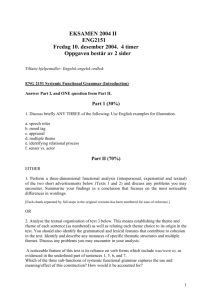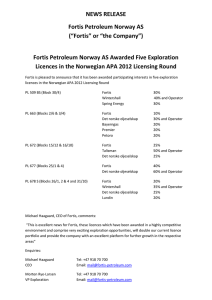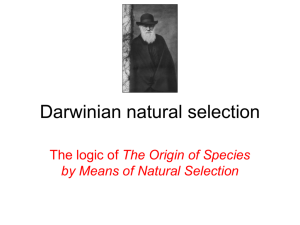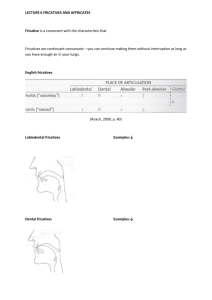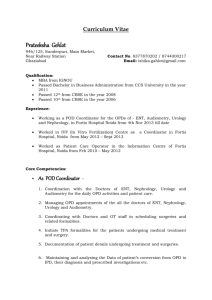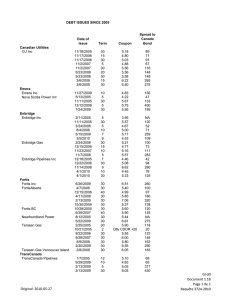Evolution of Character Displacement in Darwin’s Finches
advertisement
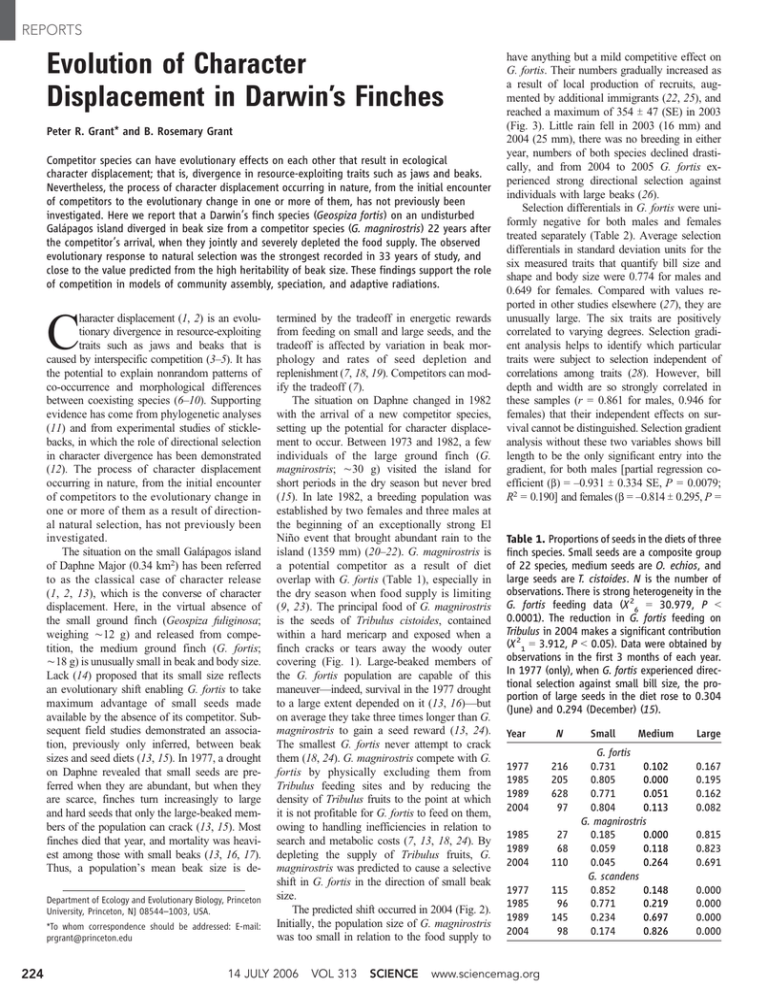
REPORTS Evolution of Character Displacement in Darwin’s Finches Peter R. Grant* and B. Rosemary Grant Competitor species can have evolutionary effects on each other that result in ecological character displacement; that is, divergence in resource-exploiting traits such as jaws and beaks. Nevertheless, the process of character displacement occurring in nature, from the initial encounter of competitors to the evolutionary change in one or more of them, has not previously been investigated. Here we report that a Darwin’s finch species (Geospiza fortis) on an undisturbed Galápagos island diverged in beak size from a competitor species (G. magnirostris) 22 years after the competitor’s arrival, when they jointly and severely depleted the food supply. The observed evolutionary response to natural selection was the strongest recorded in 33 years of study, and close to the value predicted from the high heritability of beak size. These findings support the role of competition in models of community assembly, speciation, and adaptive radiations. haracter displacement (1, 2) is an evolutionary divergence in resource-exploiting traits such as jaws and beaks that is caused by interspecific competition (3–5). It has the potential to explain nonrandom patterns of co-occurrence and morphological differences between coexisting species (6–10). Supporting evidence has come from phylogenetic analyses (11) and from experimental studies of sticklebacks, in which the role of directional selection in character divergence has been demonstrated (12). The process of character displacement occurring in nature, from the initial encounter of competitors to the evolutionary change in one or more of them as a result of directional natural selection, has not previously been investigated. The situation on the small Gal"pagos island of Daphne Major (0.34 km2) has been referred to as the classical case of character release (1, 2, 13), which is the converse of character displacement. Here, in the virtual absence of the small ground finch (Geospiza fuliginosa; weighing È12 g) and released from competition, the medium ground finch (G. fortis; È18 g) is unusually small in beak and body size. Lack (14) proposed that its small size reflects an evolutionary shift enabling G. fortis to take maximum advantage of small seeds made available by the absence of its competitor. Subsequent field studies demonstrated an association, previously only inferred, between beak sizes and seed diets (13, 15). In 1977, a drought on Daphne revealed that small seeds are preferred when they are abundant, but when they are scarce, finches turn increasingly to large and hard seeds that only the large-beaked members of the population can crack (13, 15). Most finches died that year, and mortality was heaviest among those with small beaks (13, 16, 17). Thus, a population_s mean beak size is de- C Department of Ecology and Evolutionary Biology, Princeton University, Princeton, NJ 08544–1003, USA. *To whom correspondence should be addressed: E-mail: prgrant@princeton.edu 224 termined by the tradeoff in energetic rewards from feeding on small and large seeds, and the tradeoff is affected by variation in beak morphology and rates of seed depletion and replenishment (7, 18, 19). Competitors can modify the tradeoff (7). The situation on Daphne changed in 1982 with the arrival of a new competitor species, setting up the potential for character displacement to occur. Between 1973 and 1982, a few individuals of the large ground finch (G. magnirostris; È30 g) visited the island for short periods in the dry season but never bred (15). In late 1982, a breeding population was established by two females and three males at the beginning of an exceptionally strong El NiDo event that brought abundant rain to the island (1359 mm) (20–22). G. magnirostris is a potential competitor as a result of diet overlap with G. fortis (Table 1), especially in the dry season when food supply is limiting (9, 23). The principal food of G. magnirostris is the seeds of Tribulus cistoides, contained within a hard mericarp and exposed when a finch cracks or tears away the woody outer covering (Fig. 1). Large-beaked members of the G. fortis population are capable of this maneuver—indeed, survival in the 1977 drought to a large extent depended on it (13, 16)—but on average they take three times longer than G. magnirostris to gain a seed reward (13, 24). The smallest G. fortis never attempt to crack them (18, 24). G. magnirostris compete with G. fortis by physically excluding them from Tribulus feeding sites and by reducing the density of Tribulus fruits to the point at which it is not profitable for G. fortis to feed on them, owing to handling inefficiencies in relation to search and metabolic costs (7, 13, 18, 24). By depleting the supply of Tribulus fruits, G. magnirostris was predicted to cause a selective shift in G. fortis in the direction of small beak size. The predicted shift occurred in 2004 (Fig. 2). Initially, the population size of G. magnirostris was too small in relation to the food supply to 14 JULY 2006 VOL 313 SCIENCE have anything but a mild competitive effect on G. fortis. Their numbers gradually increased as a result of local production of recruits, augmented by additional immigrants (22, 25), and reached a maximum of 354 T 47 (SE) in 2003 (Fig. 3). Little rain fell in 2003 (16 mm) and 2004 (25 mm), there was no breeding in either year, numbers of both species declined drastically, and from 2004 to 2005 G. fortis experienced strong directional selection against individuals with large beaks (26). Selection differentials in G. fortis were uniformly negative for both males and females treated separately (Table 2). Average selection differentials in standard deviation units for the six measured traits that quantify bill size and shape and body size were 0.774 for males and 0.649 for females. Compared with values reported in other studies elsewhere (27), they are unusually large. The six traits are positively correlated to varying degrees. Selection gradient analysis helps to identify which particular traits were subject to selection independent of correlations among traits (28). However, bill depth and width are so strongly correlated in these samples (r 0 0.861 for males, 0.946 for females) that their independent effects on survival cannot be distinguished. Selection gradient analysis without these two variables shows bill length to be the only significant entry into the gradient, for both males Epartial regression coefficient (b) 0 –0.931 T 0.334 SE, P 0 0.0079; R2 0 0.190^ and females (b 0 –0.814 T 0.295, P 0 Table 1. Proportions of seeds in the diets of three finch species. Small seeds are a composite group of 22 species, medium seeds are O. echios, and large seeds are T. cistoides. N is the number of observations. There is strong heterogeneity in the G. fortis feeding data (X 26 0 30.979, P G 0.0001). The reduction in G. fortis feeding on Tribulus in 2004 makes a significant contribution (X 21 0 3.912, P G 0.05). Data were obtained by observations in the first 3 months of each year. In 1977 (only), when G. fortis experienced directional selection against small bill size, the proportion of large seeds in the diet rose to 0.304 (June) and 0.294 (December) (15). Year N 1977 1985 1989 2004 216 205 628 97 1985 1989 2004 27 68 110 1977 1985 1989 2004 115 96 145 98 www.sciencemag.org Small Medium G. fortis 0.731 0.102 0.805 0.000 0.771 0.051 0.804 0.113 G. magnirostris 0.185 0.000 0.059 0.118 0.045 0.264 G. scandens 0.852 0.148 0.771 0.219 0.234 0.697 0.174 0.826 Large 0.167 0.195 0.162 0.082 0.815 0.823 0.691 0.000 0.000 0.000 0.000 REPORTS 0.0130; R2 0 0.455). Inclusion of either bill depth or bill width made no difference to these results. Overall bill size rather than bill length is identified as the most important factor distinguishing survivors from nonsurvivors in each year, by the fact that PC1bill (bill size) was a selected trait in both sexes, whereas PC2bill (bill shape) was not selected in either. There was little effect on body size, unlike in the 1977 episode. In contrast to G. fortis, the heavy mortality experienced by G. magnirostris was apparently not selective: Four surviving males did not differ from 32 nonsurvivors in any of the six measured traits (all P 9 0.1), and only 1 of 38 measured females survived. Thus, character displacement in G. fortis occurred in 2004–2005. Four lines of evidence support the causal role of G. magnirostris. First, the potential impact of G. magnirostris was greatest at the beginning of 2004 because their numbers (150 T 19) were closer to those of G. fortis (235 T 46) than at any other time (Fig. 3), and their population biomass was about the same, because a G. magnirostris individual was approximately twice the mass of a G. fortis individual. Second, G. magnirostris are largely dependent on an important food resource, Tribulus seeds, which are not renewed during droughts. G. magnirostris deplete the Tribulus seed supply faster than do G. fortis. The seeds that are Fig. 1. Large-beaked G. fortis (A) and G. magnirostris (B) can crack or tear the woody tissues of T. cistoides mericarps (D), whereas small-beaked G. fortis (C) cannot. Five mericarps constitute a single fruit. In (D), the left-hand mericarp is intact. The right-hand mericarp, viewed from the other (mesial) side, has been exploited by a finch, exposing five locules from which seeds have been extracted. Mericarps are È8 mm long and are shown at twice the magnification of the finches. [Photos are by the authors] Fig. 2. Mean beak size PC1bill of adult G. fortis (sexes combined) in the years 1973 to 2005. Vertical lines show 95% confidence intervals for the estimates of the mean. Horizontal lines mark the 95% confidence limits on the estimate of the mean in 1973 to illustrate subsequent changes in the mean. Sample sizes vary from 29 (in 2005) to 950 (in 1987). Signs of the PC values are reversed so that mean size increases from the origin. www.sciencemag.org SCIENCE VOL 313 consumed by a G. magnirostris individual each day are sufficient for two G. fortis individuals if they feed on nothing else (13). Moreover, a much higher fraction of G. magnirostris than G. fortis feed on Tribulus, as inferred from feeding observations (Table 1). As a result of their joint reduction of seed biomass, G. fortis fed on Tribulus in 2004 only half as frequently as in other years (Table 1). We did not quantify food supply; nevertheless, food scarcity was evident from the exceptionally low feeding rates of G. magnirostris. In 2004, a minimum of 90 individuals were observed foraging for Tribulus mericarps for 200 to 300 s, and none obtained seeds from more than two mericarps; whereas under the more typical conditions prevailing in the 1970s, a total of eight birds observed for the same length of time fed on 9 to 22 mericarps, with an average interval between successive mericarps of only 5.5 T 0.5 s (SE) (24). Third, numbers of G. fortis declined to a lower level (83) in 2005 than at any time since the study began in 1973, and numbers of G. magnirostris declined so strongly from the 2003 maximum that by 2005, only four females and nine males were left. The population was almost extinct, apparently as a result of exhaustion of the standing crop of large seeds and subsequent starvation. Of the 137 G. magnirostris that disappeared in 2004– 2005, 13.0% were found dead, and so were 21.7% of 152 G. fortis. Consistent with the starvation hypothesis, the stomachs of all dead birds (23 G. magnirostris and 45 G. fortis, banded and not banded individuals combined) were empty. The principal alternative food for both species is the seeds of Opuntia cactus, but production in 2004 was low, the fourth lowest since records were first kept systematically in 1982 (23). Not only were cactus seeds insufficient for the two granivore species to escape the dilemma of a diminishing supply of their preferred foods, they were insufficient for the cactus specialist G. scandens (È20 g), whose numbers, like those of G. fortis, fell lower (to 50) than in any of the preceding 32 years. The only escape was available to the smallest, most G. fuliginosa–like, members of the G. fortis population, which are known to feed like G. fuliginosa on small seeds with little individual energy reward (13, 18). We have no feeding observations to indicate that they survived as a result of feeding on the typical components of the G. fuliginosa diet: the very small seeds of Sesuvium edmonstonei and Tiquilia fusca (13, 15, 23). Nevertheless, it may be significant that two G. fuliginosa individuals were present on the island in 2004 and both survived to 2005. The fourth line of evidence is the contrast between the directions of strong selection on the G. fortis population in the presence (2004) and near absence (1977) of G. magnirostris. In 1977, a year of only 24 mm of rain and no 14 JULY 2006 225 REPORTS breeding, body size and beak size of both male and female G. fortis considered separately were subject to selection (Table 2). Average selection differentials were 0.642 for males and 0.668 for females, and they were uniformly positive. In the intervening years, 1978–2003, there was a weaker selection episode favoring G. fortis with small beaks when the food supply changed toward a predominance of small seeds and scarcity of large ones after the El NiDo event of 1982–1983 (20, 21, 23). At that time, G. magnirostris were rare (22, 25); numbers varied from 2 to 24. The selection events of 1977 and 2004 stand out against a background of relative morphological stability (29) (Fig. 2). Immediately before 2004 there was no unusual rainfall to cause a change in the composition of the food supply and no other unusual environmental factor such as temperature extremes or an invasion of predators, yet with the same amount of rain as in 1977, and with the same community of plants in the environment, large finches survived at a high frequency in 1977 but survived at a low frequency in 2004. The conspicuous difference between these years was the number of G. magnirostris: 2 to 14 occasional visitors in 1977 (15) versus 150 T 19 residents at the beginning of 2004. Given the high heritability of beak size of G. fortis (30, 31), an evolutionary response is to be expected from strong directional selection against large size (32). This was observed. The mean beak size (PC1bill) of the 2005 generation measured in 2006 was significantly smaller than that in the 2004 sample of the parental generation before selection (t176 0 4.844, P G 0.0001). The difference between generations is 0.70 SD, which is exceptionally large (27, 29). It may be compared with the range of values predicted from the breeders equation, namely the product of the average selection differential of the two sexes and the 95% confidence intervals of the heritability estimate. The observed value of 0.70 SD falls within the predicted range of 0.66 to 1.00 SD. Although a small component of the response is probably attributable to environmental factors Efood supply and finch density (30, 32)^, the major component is genetic. This is the strongest evolutionary change seen in the 33 years of the study. The evolutionary changes that we observed are more complex than those envisaged by Lack. Nevertheless, they provide direct support for his emphasis on the ecological adjustments that competitor species make to each other, specifically in the final stages of speciation and more generally in adaptive radiations (9–12, 14). They also support models of ecological community assembly that incorporate evolutionary effects of interspecific competition, in contrast Fig. 3. Numbers of G. fortis and G. magnirostris. Breeding was extensive in 1997– 1998 and 2002, and as a result finch numbers were elevated in the following years. There was no breeding in 2003 and 2004. Numbers before 1997 have been omitted because G. magnirostris were scarce (e13 pairs) (25). Table 2. Selection differentials for G. fortis in the presence (2004) and absence (1977) of G. magnirostris. Statistical significance at P G 0.05, G0.01, G0.005, and G0.001 is indicated by *, **, ***, and ****, respectively. 2004 Males Weight Wing length Tarsus length Beak length Beak depth Beak width PC1 body PC1 beak PC2 beak Sample size Proportion of survivors 226 1977 Females –0.62* –0.66* –0.48 –1.08**** –0.94*** –0.87*** –0.67* –1.02**** –0.34 47 0.34 –0.63 –0.60 0.01 –0.95* –0.91* –0.81* –0.52 –0.92* –0.26 24 0.54 14 JULY 2006 VOL 313 Males 0.88**** 0.47*** 0.24 0.75**** 0.80**** 0.71**** 0.69**** 0.80**** 0.23 164 0.45 SCIENCE Females 0.84*** 0.71** 0.27 0.88*** 0.69* 0.62* 0.73** 0.74** 0.29 55 0.42 to null or neutral models (6, 9). Replicated experiments with suitable organisms are needed to demonstrate definitively the causal role of competition, not only as an ingredient of natural selection of resource-exploiting traits (12) but as a factor in their evolution (33). Our findings should prove useful in designing realistic experiments, by identifying ecological context (high densities at the start of an environmental stress) and by estimating the magnitude of natural selection. References and Notes 1. W. L. Brown Jr., E. O. Wilson, Syst. Zool. 5, 49 (1956). 2. P. R. Grant, Biol. J. Linn. Soc. 4, 39 (1972). 3. B. W. Robinson, D. S. Wilson, Am. Nat. 144, 596 (1994). 4. D. C. Adams, F. J. Rohlf, Proc. Natl. Acad. Sci. U.S.A. 97, 4106 (2000). 5. D. W. Pfennig, P. J. Murphy, Ecology 84, 1288 (2003). 6. T. W. Schoener, in Ecological Communities: Conceptual Issues and the Evidence, D. R. Strong, L. G. Abele, A. B. Thistle, Eds. (Princeton Univ. Press, Princeton, NJ, 1984), pp. 254–281. 7. D. Schluter, T. Price, P. R. Grant, Science 227, 1056 (1985). 8. J. B. Losos, Proc. Natl. Acad. Sci. U.S.A. 97, 5693 (2000). 9. P. R. Grant, Ecology and Evolution of Darwin’s Finches (Princeton Univ. Press, Princeton, NJ, 1999). 10. D. Schluter, Am. Nat. 156, S4 (2002). 11. J. B. Losos, Evolution 44, 588 (1990). 12. D. Schluter, Science 266, 798 (1994). 13. P. T. Boag, P. R. Grant, Biol. J. Linn. Soc. 22, 243 (1984). 14. D. Lack, Darwin’s Finches (Cambridge Univ. Press, Cambridge, 1947). 15. P. T. Boag, P. R. Grant, Ecol. Monogr. 54, 463 (1984). 16. P. T. Boag, P. R. Grant, Science 214, 82 (1981). 17. T. D. Price et al., Nature 309, 787 (1984). 18. T. Price, Ecology 68, 1015 (1987). 19. C. W. Benkman, Ecol. Monogr. 57, 251 (1987). 20. H. L. Gibbs, P. R. Grant, J. Anim. Ecol. 56, 797 (1987). 21. H. L. Gibbs, P. R. Grant, Nature 327, 511 (1987). 22. P. R. Grant, B. R. Grant, Evolution 49, 229 (1995). 23. P. R. Grant, B. R. Grant, in Long-Term Studies of Vertebrate Communities, M. L. Cody, J. A. Smallwood, Eds. (Academic Press, New York, 1996), pp. 343–390. 24. P. R. Grant, Anim. Behav. 29, 785 (1981). 25. P. R. Grant, B. R. Grant, K. Petren, Genetica 112-113, 359 (2001). 26. See methods in supporting material on Science Online. 27. J. G. Kingsolver et al., Am. Nat. 157, 245 (2001). 28. R. Lande, S. Arnold, Evolution 37, 1210 (1983). 29. P. R. Grant, B. R. Grant, Science 296, 707 (2002). 30. P. T. Boag, Evolution 37, 877 (1983). 31. L. F. Keller et al., Heredity 87, 325 (2001). 32. P. R. Grant, B. R. Grant, Evolution 49, 241 (1995). 33. P. R. Grant, Science 266, 802 (1994). 34. We thank K. T. Grant, L. F. Keller, K. Petren, and U. Reyer for help with recent fieldwork, and the Charles Darwin Research Station and Galápagos National Park Service for permission and support. The research was supported by grants from NSF. Supporting Online Material www.sciencemag.org/cgi/content/full/313/5784/224/DC1 Methods References 5 April 2006; accepted 25 May 2006 10.1126/science.1128374 www.sciencemag.org
